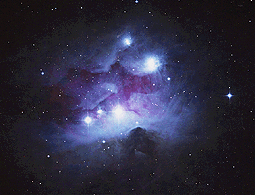
REFLECTION NEBULAE
Most reflection nebulae are blue because the tiny particles of dust that
reflect are very small. Like particles of smoke, they preferentially
scatter blue light rather than other colours, which is why most of the
reflection nebulae here are bluish. Some, however strongly reflect the
light of the star that illuminates them, such as that around Antares in UKS
30, while others reflect a brief flash of starlight from a supernova, such
as the light echo of supernova 1987A, seen in AAT 66. In one case, the dust
is reflecting the light of another nebula, that in Orion, and there is no
blue light to reflect, so the reflection nebulosity in UKS 25 appears
yellow.
AAT 12. The Trifid Nebula in Sagittarius, M20
AAT 20. Nebulosity in Sagittarius, NGC 6589-90
AAT 34. A reflection nebula in Orion, NGC 1977
AAT 66. The light echo of supernova 1987a
AAT 69. Reflection nebulosity around M 20
AAT 71. CG4, a cometary globule
AAT 73. The reflection nebula NGC 6726-7
AAT 74. Reflection nebula in NGC 6188
AAT 75. The NGC 6188 nebula and NGC 6193
AAT 96. NGC 2261, Hubble's variable nebula
UKS 4. Antares and the Rho Oph dark cloud
UKS 30. The nebula around Antares
UKS 18. The Pleiades reflection nebula
UKS 25. Between NGC 1973-77 and the Orion
Nebula

